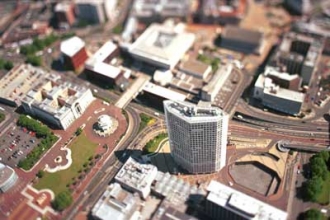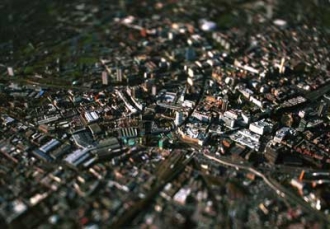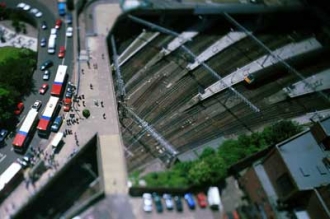About The Exhibition
Tom Merilion's photographs of Birmingham condense the city without minimising any of its impact. These images, created over an eighteen-month period, evoke the visual feel of the models from which the buildings featured evolved. This reductionist manifesto has resulted in a series of photographs that manage to get beneath the skin of the city and revitalise the ordinary with a new sense of wonder. This perspective allows the viewer to question accepted notions of scale, planning, aesthetics, architecture and beauty. The photographs overflow with an affection for, and familiarity with, the structures themselves as well as for the cultural, social and economic landmarks they represent. They are also a powerful memento of the city where Tom spent his youth and adolescence; nostalgic portraits of the landmarks by which he came to know the city.
Many of the landmarks were once held in high civic esteem, graced postcards and served as a testament to the city's motto: Forward. In a sophisticated reversal of scale, these landmarks are made to appear as nothing more substantial than pieces of a model. This subversion of perceptions of form and functionality renders the ordinary unique and the imperfect perfect. Chaotic roads become ordered and calm, streets radiate a clinical sense of order, concrete has a lustre of light and warmth and the sky a semi-tropical hue. The photographs offer the viewer the opportunity to take the role of planner and re-arrange the blocks once again to create ones own concrete dream of Birmingham.
Ben Davies
Our response to the urban design and architecture of the 1960s is one of ambivalence. We have firmly turned our backs on the policies and methods which typified the period, land use zoning, planning for unlimited car use, housing reduced to mass production, mechanised and alien architecture, considering them as being inhuman, soulless and regimented. Yet, a generation or more on, we also feel a certain admiration, not to say nostalgia, for a period when there was so much undiluted confidence in our being able to build a totally new kind of urban future. We no longer possess this confidence; partly as a result of the disillusionment we have suffered from living with the unhappy results of the huge building production of the 1950s and 60s, idealism has been replaced with cautiousness and conservatism, if not expediency.
The cataclysm of the Second World War, experienced both in the physical effect of the Blitz on British cities, and in the psychological desire of the people for a new start after the victory, created the appropriate conditions for the realisation of radical town planning ideas which had been developed in the 1930s by unfamiliar Europeans such as Le Corbusier, Hilbersheimer and Gropius. Particularly in industrial cities such as Birmingham, which possessed little that was perceived as historic, old buildings and streets were regarded as by definition obsolete. The past was an obstruction on the road to the future, comprehensive redevelopment, sweeping away a worn-out pattern and replacing it with a new one, represented modernity, represented progress. The intoxicating rhetoric about progress seems to have caused a collective amnesia in architects and planners about the timeless principles of what makes good places for people.
Part of the reason for this was the enlargement of the scale on which area planning was done, a plan for an inner ring road or an estate for 10,000 tenants was like a military operation, with no time or inclination for a concern for the quality of a sociable street corner or a sunlit pub courtyard. Military also was the mechanism of planning with small-scale models. We now find evocative the photographs of architects and councillors looking down, from a Godlike height, upon the model. It is a remote, objective viewpoint, unlike the computer fly-through on the screen which is today's equivalent. Physical patterns seen from this height become significant and attractive to an orderly mind, tower blocks standing to attention in ranks, the perfect square of the library, the geometry of speed imposing its rationale across a casually assembled landscape.
With the more empirical attitudes of today towards town planning, we have to find ways of accommodating the uncompromising products of the 60s. We neither want nor can afford another wholesale clearance of our cities, so our revisionist theories have to be applied piecemeal, collaging new and old in a pragmatic manner. Occasionally we can demolish a few prefabricated tower blocks. Some outstanding buildings of the 60s have been listed; incorporated, however awkwardly, into the heritage culture. With selective surgery, an inner ring road is transformed into a more people-friendly boulevard. The aberration that is the Bull Ring Centre, so confident an image of the modern world when new, will disappear altogether, but the Rotunda is stitched into the new street pattern. So the mechanistic deviancies of the 60s become absorbed into the urban fabric and humanised, rendered acceptable. But the mad passion for progress which informed their stark geometries remains tangible, reminding us of a time, so recent yet so distant, when we boldly believed it was possible to make a new beginning.
Joe Holyoak, Axis Design Collective









